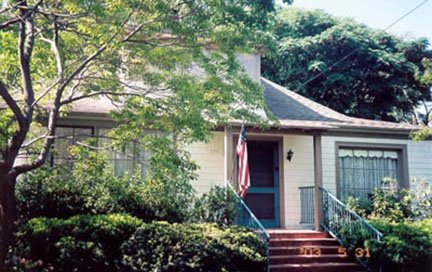2003 HERITAGE AWARD RECIPIENT
Redlands Area Historical Society
Charles Wood Hobbs House
136 East Hilton Avenue
1903
In 1903, an improvement was taxed for the first time at 136 East Hilton Avenue. It is apparent Charles W. Hobbs had owned the entire block for many years but no record exists of a building permit for this year.
Did Charles Hobbs have this exquisite example of a Victorian Shingle house moved to the current location in the middle of the south side block? Therein lies the mystery. Why did he move it and where did the house come from? Olive and Emma Jane Lawson told Fritz and Corrine Bromberger, the present owners, the house had been moved. These well-know Redlands sisters apparently played with the Hobbs’ girls when they were growing up. However, one must keep in mind that Olive was born in 1911 and Emma Jane in 1913. Obviously the oral history of this lovely home has been handed down through the years so that it has become a part of the heart and soul of this house. In 1990, the McCormicks sold the house to the Brombergers and explained that it had come from “down there” to the east. It seems that this house was originally situated on “two dirt roads, Perley Avenue and Franklin” and Mr. Hobbs wanted to move it away from all the dirt created by wagon traffic. Some believe that around 1892 the original address was 153 East Hilton Avenue, which would indicate that it once sat on the north- west corner of Hilton and Franklin. Although it is unknown exactly where the house first sat, it is clear that it was originally in this vicinity and situated in a grove. Hobbs merely gave it a more prominent position by moving the structure. As a final note, the Victorian Shingle style was relatively uncommon and traditionally built between 1880 to 1900, which lends support to a construction date prior to 1903.
The Shingle style does not emphasize decorative detailing but rather is a continuous design of wood singles without interruption at the corners. Even the hipped roof would have originally had wooden shingles but is often replaced by composition shingles, as is the case here. The Shingle house should appear as a complex shape inside a smooth surface, which unifies the irregular outline of the house. The front of the house is asymmetrical in design with the porch and front door slightly off center. Originally the four dormers, one on each side of the house, were identical but above the front door we see an expanded version done in the 1930s by Charlie Hobbs. Traveling around the house to the east, the front windows rap around the corner and then we see another dormer plus many more irregular pop-outs. Across the back we can see one small-enclosed porch with lap siding and another small-hipped roof. Even the eight-foot living room expansion, done by Charlie Hobbs in 1937, is sided with shingles.
Two lovely gazebos are on the property. The 1991 hip roofed gazebo the Brombergers built in back mirrors the front gazebo, built March 1911 by Charlie Hobbs. True to the architecture, the 1991 two-car garage has a hipped roof and dormer as well. Charlie Hobbs did a great job dating each building project. Not only is the gazebo dated, but also the excedra (“outdoor bench” in Greek) 1932, and a brick walkway, 1938.
Six families have lived in this home over the years. Interestingly, in 1903 Frederick and Josephine Hibbert deeded the property to Kate Potts Hobbs only. Then in 1929 Kate Potts Hobbs and Charles W. Hobbs, husband and wife, deeded the property to Charles W. Hobbs, Junior. However, the Redlands City Directory lists Charles W. Hobbs, Jr. and his wife Hazel J. Hobbs continuously in residence at this location until 1934. So was it the father or the son who moved the house here? Although it was probably Charlie’s parents who officially owned the property they never lived here. Since Junior officially took ownership in 1929, this gives us an explanation for all the renovations Charlie made in the 1930s. In 1934 Hazel died from a brain tumor at the age of 51. This was the same year her husband commissioned the Mary Queen of Heaven window for Trinity Episcopal Church. Hazel Hobbs was a sister of Frank Brown, co-founder of Redlands. Charlie continued to reside here until 1943 when he sold the property to Charles and Violet Burris. Subsequent owners were, Anthony and Grace Figueredo, 1945, Volney and Ruth Kincaid, 1950 (they removed the groves and subdivided the land), James and Virginia McCormick, 1968, and finally the Brombergers in 1990.
The Redlands Area Historical Society congratulates Fritz and Corrine Bromberger for continuing to maintain the authenticity of this charming historical Victorian Shingle style home.
Researched and written by Judith G. Hunt


